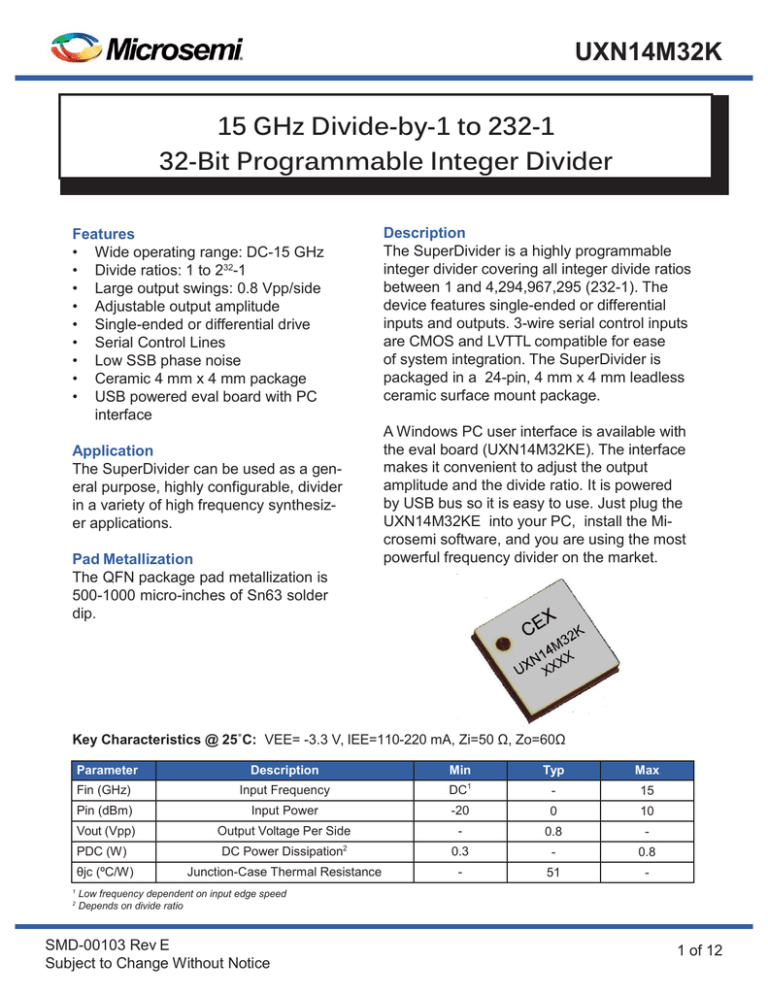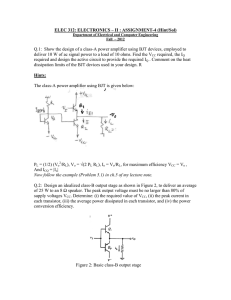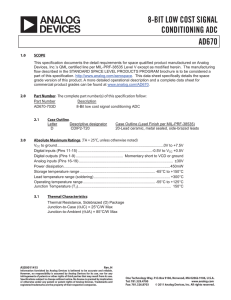
UXN14M32K
15 GHz Divide-by-1 to 232-1
32-Bit Programmable Integer Divider
Description
The SuperDivider is a highly programmable
integer divider covering all integer divide ratios
between 1 and 4,294,967,295 (232-1). The
device features single-ended or differential
inputs and outputs. 3-wire serial control inputs
are CMOS and LVTTL compatible for ease
of system integration. The SuperDivider is
packaged in a 24-pin, 4 mm x 4 mm leadless
ceramic surface mount package.
Features
• Wide operating range: DC-15 GHz
• Divide ratios: 1 to 232-1
• Large output swings: 0.8 Vpp/side
• Adjustable output amplitude
• Single-ended or differential drive
• Serial Control Lines
• Low SSB phase noise
• Ceramic 4 mm x 4 mm package
• USB powered eval board with PC
interface
A Windows PC user interface is available with
the eval board (UXN14M32KE). The interface
makes it convenient to adjust the output
amplitude and the divide ratio. It is powered
by USB bus so it is easy to use. Just plug the
UXN14M32KE into your PC, install the Microsemi software, and you are using the most
powerful frequency divider on the market.
Application
The SuperDivider can be used as a general purpose, highly configurable, divider
in a variety of high frequency synthesizer applications.
Pad Metallization
The QFN package pad metallization is
500-1000 micro-inches of Sn63 solder
dip.
Key Characteristics @ 25˚C: VEE= -3.3 V, IEE=110-220 mA, Zi=50 Ω, Zo=60Ω
Parameter
1
2
Description
Min
Typ
Max
1
-
15
Fin (GHz)
Input Frequency
DC
Pin (dBm)
Input Power
-20
0
10
Vout (Vpp)
Output Voltage Per Side
-
0.8
-
2
PDC (W)
DC Power Dissipation
0.3
-
0.8
θjc (ºC/W)
Junction-Case Thermal Resistance
-
51
-
Low frequency dependent on input edge speed
Depends on divide ratio
SMD-00103 Rev E
Subject to Change Without Notice
1 of 12
UXN14M32K
Typical Performance
SMD-00103 Rev E
Subject to Change Without Notice
2 of 12
UXN14M32K
Typical Performance
Divide-by-3
Input Frequency = 10 GHz
SMD-00103 Rev E
Subject to Change Without Notice
Divide-by-10
Input Frequency = 10 GHz
3 of 12
UXN14M32K
Functional Block Diagram
Table 1: Pin Description
Port Name
Description
Notes
INP
Divider input, positive terminal
CML signal levels
INN
Divider input, negative terminal
CML signal levels
OUTP
Divider output, positive terminal
Requires DC return path to VCC
OUTN
Divider output, negative terminal
Requires DC return path to VCC
VCC
RF & DC ground
-
VEE
-3.3 V @ 220 mA
Negative supply voltage
LE
Load enable
CMOS levels, defaults to logic 0
DAT
Serial data input
CMOS levels, defaults to logic 0
CLK
Serial clock input
CMOS levels, defaults to logic 0
HLD
Output hold control
CMOS levels, defaults to logic 0
RST
Divider reset control
CMOS levels, defaults to logic 0
VADJ
Output amplitude control
Tie to VCC via resistor, refer to text for value
TEMP
Temperature diode
Optional temperature diode, refer to text
Simplified Control Logic Schematic
Table 2: Pin Description
Logic Level
Minimum
Typical
Maximum
1 (High)
VCC-1.25 V
VCC
VCC
0 (Low)
VEE
VEE
VEE+1.25 V
SMD-00103 Rev E
Subject to Change Without Notice
4 of 12
UXN14M32K
Programming Divide Ration
Note: Maximum CLK frequency is estimated to be 30 MHz.
Equation 1
Divider Modulus = N = P0 · 20 + P1 · 21 + P2 · 22 + ... + P31 · 231
for 1 < N < (232-1)
Note: When N=0, HLD must be pulled high to ensure that the output does not enter meta-stable state.
Table 3: OEE vs. Divide Ratio
SMD-00103 Rev E
Subject to Change Without Notice
N
IEE (mA)
0
110
1
135
2-3
165
4-7
180
8-15
190
16-31
200
32-63
210
≥64
220
5 of 12
UXN14M32K
Application Notes
Low Frequency Operation:
Low frequency operation is limited by external bypass capacitors and the slew rate of the input clock.
The next paragraph shows the calculations for the bypass capacitors. If DC coupled, the device
operates down to DC for square-wave inputs. Sine-wave inputs are limited to ~50 MHz due to the 10
dBm max input power limitation.
The values of the coupling capacitors for the high-speed inputs and outputs (I/O’s) is determined by
the lowest frequency the IC will be operated at.
C>>
1
2∙π∙50 Ω∙flowest
For example: to use the device below 30 kHz, coupling capacitors should be larger than 0.1 µF
IC Assembly:
The device is designed to operate with either single-ended or differential inputs. Figures 4, 5 & 6
show the IC assembly diagrams for positive and negative supply voltages. In either case the supply should be capacitively bypassed to the ground to provide a good AC ground over the frequency
range of interest. The backside paddle of the QFN package should be connected to a good thermal
heat sink.
All RF I/O’s are connected to Vcc through on-chip termination resistors. This implies that when Vcc
is not DC grounded (as in the case of positive supply), the RF I/O’s should be AC coupled through
series capacitors unless the connecting circuit can generate the correct levels through level shifting.
ESD Sensitivity:
Although SiGe IC’s have robust ESD sensitivities, preventive ESD measures should be taken while
storing, handling, and assembling.
Inputs are more ESD susceptible as they could expose the base of a BJT or the gate of a MOSFET.
For this reason, all the inputs are protected with ESD diodes. These inputs have been tested to withstand voltage spikes up to 400 V.
Table 4: Negative CML Logic Levels for DC Coupling (T=25˚C) Assuming 50Ω terminations
at inputs and outputs
Parameter
Differential
Minimum
Typical
Maximum
{
Logic Inputhigh
Vcc
Vcc
Vcc
Logic Inputlow
Vcc – 0.05 V
Vcc – 0.3 V
Vcc – 1 V
{
Logic Inputhigh
Vcc + 0.05 V
Vcc + 0.3 V
Vcc + 1 V
Logic Inputlow
Vcc – 0.05 V
Vcc – 0.3 V
Vcc – 1 V
{
Logic Inputhigh
Vcc
Vcc
Vcc
Logic Inputlow
Vcc – 0.2 V
Vcc – 0.3 V
Vcc – 1 V
Input
Single
Output
Differential & Single
MM-PDS-0035 Rev A
Subject to Change Without Notice
6 of 12
UXN14M32K
Temperature Diode:
An optional on chip temperature diode is provided
for users Interested in evaluating the IC’s temperature.
A single resistor to VCC establishes a nominal current
through the diode. The voltage developed across
the temperature pin (pin 20) referenced to VEE (pin 22) can
then be used to indicate the surface temperature
to the IC. The plot in figure 1 was obtained by forcing
a fixed current of approximately 120 µA through the diode
for an unbiased device at multiple temperatures and fitting a
line to the data to allow extrapolation over a range
of temperatures. In this case, the temperature
can be calculated by the following formula:
T=
Vd – 0.84
-0.00133
Package Heatsink:
The package backside provides the primary heat conduction path and should be attached to a good
heatsink on the PC board to maximize performance. User PC boards should maximize the contact
area to the package paddle and contain an array of vias to aid thermal conduction to either
a backside heatsink or internal copper planes.
Divider Outputs:
The equivalent circuit of the divider outputs is shown below. The outputs require a DC return path
capable of handling ~20 mA per side. If DC coupling is employed, the DC resistance of the receiving
circuits should be ~50 ohms (or less) to VCC to prevent excessive common mode voltage from
saturating the prescaler outputs. If AC coupling is used, the recommended configuration is shown in
figure 3. The discrete R/L/C elements should be resonance free up to the maximum frequency
of operation for broadband applications.
The output amplitude can be adjusted over a 10:1 range by one of two methods. Voltage at the VADJ
pin can be set to a value between VCC, for maximum amplitude, and VCC-2.4 V for an amplitude
~1/10 the max swing. Voltages between these two values will produce a linear change in output
swing.
Vout ~ [1.1 - 0.44*(VCC - VADJ)] * (VCC - VEE - 0.8) / 2.5
Alternatively, output amplitude can be adjusted by connecting a 10 kΩ potentiometer between
VADJ and VCC. Resistor values approaching 0 Ohms will lead to the maximum swing, while values
approaching 10 kΩ will lead to the minimum output swing. If adjustable output amplitude is not
needed, users can either tie VADJ to VCC for maximum swing, or insert a resistor Rx between
VADJ and VCC for a lower fixed swing.
Vout ~ [1.1 - 0.44*Rx*(VCC - VEE - 0.8) / (Rx + 580) ] * (VCC - VEE - 0.8) / 2.5
MM-PDS-0035 Rev A
Subject to Change Without Notice
7 of 12
UXN14M32K
The output amplitude can be adjusted over a 10:1 range by one of two methods. Voltage
at the VADJ pin can be set to a value between VCC, for maximum amplitude, and VCC-2.4 V
for an amplitude ~1/10 the max swing. Voltages between these two values will produce a linear
change in output swing.
Vout ~ [1.1 - 0.44*(VCC - VADJ)] * (VCC - VEE - 0.8) / 2.5
Alternatively, output amplitude can be adjusted by connecting a 10 kΩ potentiometer between
VADJ and VCC. Resistor values approaching 0 Ohms will lead to the maximum swing, while values
approaching 10 kΩ will lead to the minimum output swing. If adjustable output amplitude is not
needed, users can either tie VADJ to VCC for maximum swing, or insert a resistor Rx between
VADJ and VCC for a lower fixed swing.
Vout ~ [1.1 - 0.44*Rx*(VCC - VEE - 0.8) / (Rx + 580) ] * (VCC - VEE - 0.8) / 2.5
NOTE: The formulas provided
are approximations only,
and do not account for process,
temperature and frequency variations.
Differential vs. Single-Ended:
The UXN14M32K is fully differential to maximize signal-to-noise ratios for high-speed operation.
All high speed inputs and outputs are terminated to VCC with on-chip resistors (refer to functional
block diagram for specific resistor values). The maximum DC voltage on any terminal must be limited
to VCC +/- 1 V to prevent damaging the termination resistors with excessive current. Regardless
of bias conditions, the following equation should be satisfied when driving the inputs differentially:
VCC -1 < VAC/4 + VDC < VCC +1
where VAC is the input signal p-p voltage and VDC is common-mode voltage.
In addition to the maximum input signal levels, single-ended operation imposes additional
restrictions: the average DC values at the two inputs to the IC should be equal for the best
sensitivity. The unused input should be terminated to ground through the same elements
on the active input side to reduce reflections at high frequencies and to achieve equal DC values.
For example, if the active input source termination is 50 Ohms and has a DC-blocking capacitor,
then the unused input should be terminated through 50 Ohms and the same value of DC-blocking
capacitance to ground.
Note that a potential oscillation mechanism exists if both inputs are static (i.e. no signal) and have
identical DC voltages; a small DC offset on either input is sufficient to prevent possible oscillations.
Connecting a 10k ohm resistor between either the unused input and VEE should provide sufficient
offset to prevent oscillation. The RST and HLD controls can also be used to prevent such oscillations
from occurring.
MM-PDS-0035 Rev A
Subject to Change Without Notice
8 of 12
UXN14M32K
Rest and Hold:
There are several different ways to disable the divider output, apart from removing the DC bias
altogether. The control line RST resets all divider states to logic low, preventing any circuits from
toggling while invoked. OUTP will be low and OUTN will be high. HLD also holds the outputs
constant, but unlike RST, the divider core is still functional. In either case, the divide ratio is not
affected and can be updated independent of whether RST and/or HLD are enabled or disabled. While
HLD is enabled, the divide ratio can be set to zero in order to achieve minimum supply
current draw. Finally, VADJ can be pulled down to VEE in order to fully shut down the output
buffer, achieving even lower current draw. In that case, both output voltages will be near VCC.
Table 5: RST and HLD Logic
Control
Logic Level
Mode
RST
0
1
Reset Disabled
Reset Enabled
HLD
0
1
Hold Disabled
Hold Enabled
Negative Supply (DC Coupling)
Biasing recommendations for negative supply with DC coupling applications
MM-PDS-0035 Rev A
Subject to Change Without Notice
9 of 12
UXN14M32K
Negative Supply (AC Coupling)
Biasing recommendations for negative supply with AC coupling applications
Positive Supply (AC Coupling)
Biasing recommendations for positive supply with AC coupling applications
MM-PDS-0035 Rev A
Subject to Change Without Notice
10 of 12
UXN14M32K
Duty Cycle:
The SuperDivider duty cycle varies between
33% and 66% as a function of the divide ratio,
N. When N is a power of 2, the duty cycle
is exactly 50%. As N deviates from a power
of 2, so does the duty cycle deviate from 50%.
For example, N=64 has 50% duty cycle, N=60
has 47% duty cycle, and N=56 has 43% duty
cycle. Equations 2 and 3 provide formulas
for calculating pulse width and duty cycle
as a function of N, for any integer N from
2 to (232-1). Table 5 shows the pulse width
and duty cycle for N from 2 to 16, and duty
cycle versus N is plotted below for N from
2 to 1024.
Equation 2:
Pulse Width (input cycles) = N – 2floor [log2(N/3) + 1]
Equation 3:
Duty Cycle (1%) =
Pulse Width
MM-PDS-0035 Rev A
Subject to Change Without Notice
x 100%
Table 6: Duty Cycle for N = 2 to 16
Pulse Width
(Input Cycles)
Duty Cycle (%)
2
1
50
3
1
33
4
2
50
5
3
60
6
2
33
7
3
43
8
4
50
9
5
55
10
6
60
11
7
63
12
4
33
13
5
38
14
6
43
15
7
47
16
8
50
Divide Ratio
11 of 12
UXN14M32K
UXN14M32K Physical Characteristics
Pkg size:
4.00 x 4.00 mm
Pkg size tolerance:
+/- 0.25 mm
Pkg thickness:
1.05 +/- 0.1 mm
Pad dimensions:
0.30 x 0.35 mm
Center paddle:
2.5 x 2.5 mm
JEDEC designator:
MO-220
Bottom View
Table 7: UXN14M32K Pin Assignment
Function
Notes
1,7,9,18,22,23 (VEE)
Negative supply voltage
Nominally -3.3 V
2,5,8,14,17,21,24 (VCC)
RF and DC ground
0V
3 (INN)
Divider input
Negative terminal of differential input
4 (INP)
Divider input
Positive terminal of differential input
6 (RST)
Divider reset control
Defaults to logic 0, connect to VCC for logic 1
10 (DAT)
Serial input data
Defaults to logic 0, connect to VCC for logic 1
11 (CLK)
Serial input clock
Defaults to logic 0, connect to VCC for logic 1
12 (LE)
Load enable
Defaults to logic 0, connect to VCC for logic 1
13 (HLD)
Hold output control
Defaults to logic 0, connect to VCC for logic 1
15 (OUTP)
Divider output
Positive terminal of differential output
16 (OUTN)
Divider output
Negative terminal of differential output
19 (VADJ)
Output amplitude control
Tie to VCC for max swing, refer to text
20 (TEMP)
Temperature diode
IC surface temperature, refer to text
Paddle
Package paddle
Tie to heatsink, refer to text
Table 8: Absolute Maximum Ratings
Parameter
Value
Unit
Supply voltage (VEE)
-3.8
V
RF input power (INP,INN)
10
dBm
Operating temperature
-40 to 85
ºC
Storage temperature
-85 to 125
ºC
Junction Temperature
125
ºC
Operation beyond the values listed under the Absolute Maximum Ratings may cause permanent damage to the device. These are stress ratings only,
and functional operation of the device at these or any other conditions beyond those indicated in the Operating Specifications is not implied. Prolonged
use at the absolute maximum rating conditions may affect device reliability.
MM-PDS-0035 Rev A
Subject to Change Without Notice
12 of 12
UXN14M32K
Information contained in this document is proprietary to Microsem. This document may not be modified in any way without the express
written consent of Microsemi. Product processing does not necessarily include testing of all parameters. Microsemi reserves the right to
change the configuration and performance of the product and to discontinue product at any time.
Microsemi Corporate Headquarters
Microsemi Corporation (Nasdaq: MSCC) offers a comprehensive portfolio of semiconductor
One Enterprise, Aliso Viejo CA 92656 USA and system solutions for communications, defense and security, aerospace, and industrial
Within the USA: +1 (949) 380-6100
markets. Products include high-performance and radiation-hardened analog mixed-signal
Sales: +1 (949) 380-6136
integrated circuits, FPGAs, SoCs, and ASICs; power management products; timing and
Fax: +1 (949) 215-4996
synchronization devices and precise time solutions, setting the world’s standard for time;
voice processing devices; RF solutions; discrete components; security technologies and
scalable anti-tamper products; Power-over-Ethernet ICs and midspans; as well as custom
design capabilities and services. Microsemi is headquartered in Aliso Viejo, Calif. and has
approximately 3,400 employees globally. Learn more at www.microsemi.com.
© 2014 Microsemi Corporation. All rights reserved. Microsemi and the Microsemi logo are trademarks of Microsemi Corporation. All other
trademarks and service marks are the property of their respective owners.
MM-PDS-0035 Rev A
Subject to Change Without Notice
13 of 13



